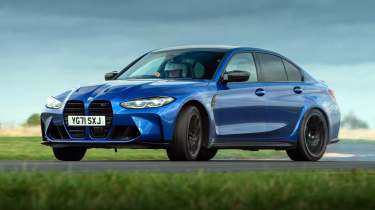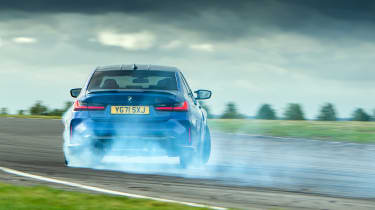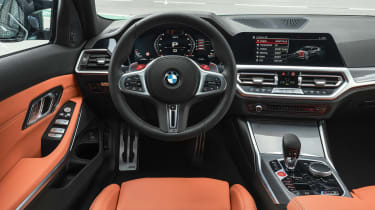BMW M3 Competition xDrive 2021 review – best with all-wheel drive?
The launch of an all-wheel drive BMW M3 might seem like sacrilege, but it might just be the one you should opt for
BMW’s new G80 M3 Competition has already confounded the doubters. When announced, the idea of a significant weight gain (the M3 is now a 1730kg car), the switch to a torque converter automatic gearbox away from the previous M-DCT twin clutch box, and of course, the highly divisive styling, had onlookers wondering if the M department really had lost the plot.
However, credit where it’s due, we’ve fallen for the M3 (and the M4) in a big way here on evo the more we’ve driven the car, and so while the inclusion of four-wheel drive system may seem to the purists the anathema of what an M3 has come to stand for, recent history suggests the M division is more than capable of successfully integrating the setup. And anyway, it hasn’t done the current M5 any harm at all. On the contrary, it’s made for a better car.
There’s no way of distinguishing an xDrive equipped M3 from a rear-wheel drive one. There’s no subtle badging to speak of, no difference in body trim or wheel design. The xDrive setup is similar to the one used on the M5 in that it uses an electronically-controlled multi-plate clutch in the transfer case, and in normal driving is largely rear-wheel drive. Only when there’s a loss of grip at the rear axle do the front driveshafts come into play, their keenness to intervene depending on whether the car is in its standard 4WD setting or in 4WD Sport, the latter setting biased towards a rear-wheel drive handling style. And like the M5 (but not lesser 5s like the M550i), you can also choose to disable the ESP system completely and then force the car into a purely rear-wheel drive setting, too. Much of the four-wheel drive hardware is bespoke for the M3/M4, and it also has its own front suspension tuning and geometry over the rear-drive car, plus the engine’s oil system has also been upgraded.
There’s a 50kg weight penalty for all this, which is inevitable. Yet while any weight gain is to be regretted, as a percentage of the car’s overall weight it is a small one, and on the road the M3 feels no less responsive to the throttle (against the clock, launching from 0-62mph, it’s predictably faster, by 0.4 seconds no less, reducing the sprint time down to just 3.5 seconds). In fact, it doesn’t really feel any different to the rear-drive car at all, which is pretty mystifying when you come to think about it. I drove both four- and rear-drive cars back to back, down the same piece of road, and as much as I search for differences in steering response, weight, and handling balance, the xDrive just feels the same as the regular car. That’s a tremendous achievement right there, because you could never say the same thing about a 992 Carrera and Carrera 4, for example.
More reviews
Group tests
In-depth reviews
Reviews
- BMW M3 Touring 2025 review – the best fast estate gets even better
- Used BMW M3 (E46, 2000 - 2006): an analogue sports coupe icon
- BMW M3 CS Touring 2025 review – the Nürburgring’s fastest-ever estate tested
- Used BMW M3 CS (E46, 2005 - 2006) review – BMW M's forgotten modern classic
- BMW M3 (2007 - 2013, E92) review and specs for V8 coupe
- BMW M3 CS 2023 review
Of course, you can get to a point where the xDrive car does feel different, and that’s when the limit of grip is exceeded - and this is where it gets very clever. When in its normal setting the four-wheel drive system provides the M3 with a tremendous sense of surefootedness, and an ability to deploy all 503bhp just about anywhere and at any time. In 4WD Sport, it will allow much more slip at the rear axle, but whereas in the rear-drive car you’d be managing that slip with the throttle, the xDrive simply hooks up after a certain point and hauls out of the corner. It’s impressive, not just because of the outright level of performance it gives the car, but also because unlike so many other systems, it doesn’t feel particularly ‘four-wheel drive’. There’s no ‘snatch’ from the front axle as it takes up the slack, no urgent steering correction required on the exit of the corner to make sure the front wheels are pointing where they’re now powering towards: in fact, it just feels like the rear-driven chassis but with a huge dollop of additional traction.
We also tried the xDrive with the optional Michelin Cup 2 tyre instead of the regular Michelin 4S. Road noise was increased, while ride comfort took a small but noticeable hit too. The tyres need heat in them to give their best, and when very cold at the start of a journey there can be some pronounced sudden oversteer with almost no provocation. However, once they’re at working temperature the combination of the M3’s power and chassis, with four-wheel drive traction and the sticky rubber makes for a car that from point A to point B, must surely be one of the fastest machines at any price. The fact that five people and their luggage can experience it is an added bonus.
Prices and rivals
As you might expect, there’s a small premium to pay for the xDrive models - in the case of the M3, that means the price rises from £75,660 to £79,755. Frankly, given the additional abilities of the xDrive car that doesn’t feel like too high a price to pay for what, surprisingly, might just be the pick of the current M3 range.
> 2022 BMW M3 Touring spied ahead of reveal






